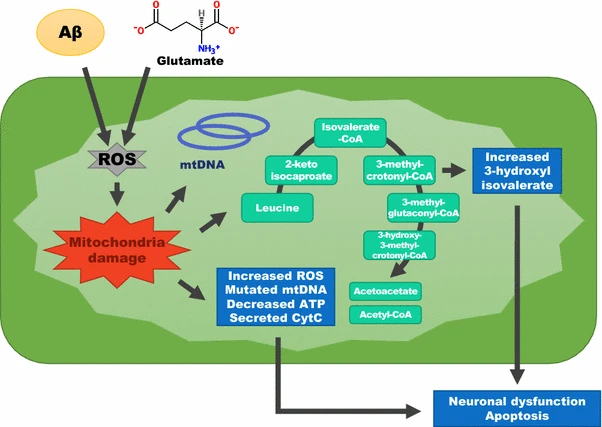Mitochondrial Metabolomics Analysis Services
Mitochondria are essential organelles responsible for energy synthesis within cells, playing key roles in oxidative phosphorylation, fatty acid oxidation, amino acid metabolism, and apoptosis. Mitochondrial metabolomics analysis focuses on the comprehensive profiling of metabolites within mitochondria, aiming to elucidate their functional mechanisms in cellular energy regulation and metabolic networks. This service utilizes high-resolution mass spectrometry, combined with mitochondrial isolation and enrichment procedures, to accurately capture the types, abundances, and dynamic changes of mitochondrial metabolites. Metabolic pathway analysis is also applied to enable a comprehensive understanding of mitochondrial metabolic states.
Mitochondrial metabolomics analysis services are widely used in fields such as metabolic diseases, neurodegenerative disorders, and cancer research. By studying mitochondrial metabolites, researchers can gain deeper insights into the role of mitochondrial dysfunction in disease development, such as in diabetes and Alzheimer’s disease, while also providing crucial data to support investigations into metabolic regulation, drug development, and disease mechanisms.

Kim, D H. et al. Genes & Genomics, 2016.
Figure 1. Mitochondrial Dysfunction Is Observed in Many Common Neurodegenerative Disorders.
Services at MtoZ Biolabs
Based on highly sensitive LC-MS/MS and GC-MS platforms, MtoZ Biolabs’ mitochondrial metabolomics analysis services focus on the comprehensive profiling of metabolites within mitochondria. Through rigorous mitochondrial isolation and extraction procedures, we ensure the accuracy and representativeness of metabolite data. This service not only reveals metabolite types and relative abundances but also supports pathway analysis and metabolic pattern recognition, helping researchers gain in-depth insights into the critical roles of mitochondria in energy regulation, signal transduction, and disease progression. Our offerings include, but are not limited to, the following:
1. Untargeted Metabolomics
Aimed at globally profiling mitochondrial metabolites without predefined targets, this approach is ideal for discovering novel metabolic pathways, identifying unknown biomarkers, and exploring disease mechanisms.
2. Targeted Metabolomics
Focused on the quantitative analysis of specific metabolites or metabolic pathways, this method offers high sensitivity and specificity, making it suitable for hypothesis validation, metabolite quantification, and functional mechanism studies.
Analysis Workflow
1. Mitochondrial Isolation and Extraction
Mitochondria are isolated from cells or tissues with high purity using differential centrifugation and related techniques, providing a dedicated sample source for subsequent metabolite analysis.
2. Metabolite Extraction
Extraction protocols optimized for polar or non-polar metabolites are applied to ensure maximum preservation and recovery of mitochondrial metabolites.
3. Mass Spectrometry Detection
High-resolution mass spectrometry platforms are used for metabolite detection and data acquisition, supporting both untargeted and targeted metabolomics strategies.
4. Data Analysis and Interpretation
Multivariate statistical analysis and metabolic pathway mapping are conducted to identify differential metabolites, perform functional enrichment, and interpret biological significance.
Sample Submission Suggestions
1. Sample Types
Suitable for animal or plant cells, tissue samples, as well as pretreated mitochondrial fractions. Fresh or flash-frozen samples are recommended to minimize metabolite degradation.
2. Sample Storage and Transportation
Samples should be stored at −80°C immediately after processing and transported on dry ice at all times to avoid repeated freeze-thaw cycles and preserve metabolite stability.
3. Additional Information
If partial pretreatment (e.g., homogenization or extraction) has been performed, please specify the buffer systems and handling steps used to facilitate assessment of data consistency and comparability.
Service Advantages
1. Efficient Mitochondrial Purification
By combining optimized differential centrifugation and density gradient separation techniques, we ensure the acquisition of highly purified, low-contaminant mitochondrial samples—establishing a reliable foundation for subsequent metabolite analysis.
2. Sensitive and Stable Mass Spectrometry Platforms
Relying on high-resolution LC-MS/MS and GC-MS platforms, our service accommodates various metabolite detection needs with excellent sensitivity and reproducible quantification performance.
3. Comprehensive Metabolic Coverage
Supporting both targeted and untargeted metabolomics, the analysis spans key pathways including energy metabolism, redox balance, and intermediate metabolism, enabling the identification of functional changes.
4. One-Stop Service Support
We offer a full workflow from sample processing and metabolite extraction to mass spectrometry detection and bioinformatics analysis—ensuring both data quality and research efficiency are enhanced.
Applications
1. Metabolic Disease Research
Mitochondrial metabolomics analysis services are applicable to investigating mitochondrial metabolic pathway alterations in disorders such as diabetes and obesity, offering insights into potential therapeutic targets.
2. Neurodegenerative Disease Research
These services support the study of how mitochondrial dysfunction affects neuronal metabolism in conditions like Parkinson’s disease and Alzheimer’s disease.
3. Cancer Metabolism Research
Mitochondrial metabolomics analysis services can be used to uncover the characteristics of mitochondrial metabolic reprogramming in cancer cells, facilitating the development of cancer biomarkers and novel targeted therapies.
4. Aging and Oxidative Stress Research
Exploring mitochondrial metabolic regulation during aging and cellular stress responses, this service contributes to anti-aging strategies and cellular repair investigations.
FAQ
Q1: Is Mitochondrial Metabolomics Analysis Supported for Frozen Samples?
A1: Yes, it is supported. We recommend preserving samples through snap-freezing in liquid nitrogen and storing them at −80°C to maintain the original state of metabolites. Repeated freeze-thaw cycles should be avoided.
Q2: What Is the Difference between Untargeted and Targeted Metabolomics?
A2: Untargeted analysis focuses on comprehensive metabolite profiling and novel biomarker discovery, while targeted analysis quantifies known metabolites within specific metabolic pathways, making it suitable for mechanistic studies and hypothesis validation.
Q3: Can Targeted Quantification of Metabolites Be Performed Independently?
A3: Yes. We offer various targeted quantification panels covering common pathways such as energy metabolism, amino acid metabolism, and lipid metabolism. Custom analysis solutions are also available upon request.
Deliverables
1. Comprehensive Experimental Details
2. Materials, Instruments, and Methods
3. Data Analysis, Preprocessing, and Estimation
4. Bioinformatics Analysis
5. Raw Data Files
How to order?







